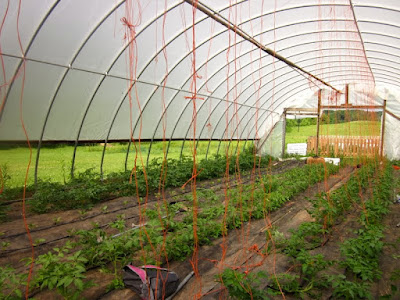This week we are happy to have Anna, Alice, Ruby and Shyamoli here to work in the garden and take on big facilities projects.
Today we planted almost 2500 sweet corn plants and then they did some much needed deep-cleaning in the residential wings.
Tomorrow more planting and weeding and fertilizing. Also Tomato trellising.
Also. Jen and I saw two more bears yesterday! Definitely time to google what to do if you see a black bear.
Here's what I gathered:
1. Don't surprise a bear. Make noise in dense brushy areas with low visibility. Use "bear bells" or sing or clap occasionally. You can often smell that a bear is in the area. If you smell a deep musky smell, that is your cue to make more noise.
2. Never get between a bear sow and her cub. Likewise, always allow the bear a clear path of escape.
3. If the bear has not seen you, walk away in the other direction, or walk in a wide circle around the bear, upwind so the bear is less likely to smell you. If the bear has seen you, talk to it in a low calm voice. Bears have poor eyesight and talking will help them recognize you as human. Don't run away. Make yourself as big as possible and back away while talking to the bear and keeping your eyes on the bear, without making direct eye contact. If necessary, walk around the bear downwind so the bear can smell you and know where you are.
4. If a black bear engages aggressively with you, do not "play dead." First stand your ground and wave your arms or wave a stick to look "big" (courage!). The charge is most likely a "bluff charge." Then, if necessary, fight back (only for black bears). Climb a tree only as a last resort. Black bears can climb trees quite easily, but might lose interest if you are up a tree.
5. Don't feed the bears. Never, ever. This includes not making food or garbage available to a bear. It also includes not bringing food into your tent. This rule extends to some toothpastes. A bear that is habituated to eating people food and garbage will lose natural fear of people.
6. Don't panic. Black bears are very rarely aggressive to humans. If they know you are human, they will usually try to walk away.
7. Don't follow a bear or try to get close for a good photo.
8. In the event that a bear is at your campsite and about to eat all your food, try scaring it away by yelling at it.
The inclusion of the following links is not an endorsement, but just good for further reading.
http://www.bear.org/website/
http://nrs.fs.fed.us/epubs/ht66.html#visits

































